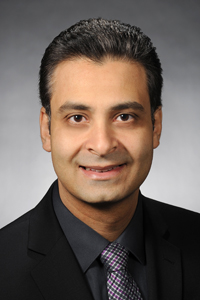
Power management is a critical aspect in many electronic devices, and Ayman Fayed is working on a new approach to the problem. Fayed, assistant professor of electrical and computer engineering, has received a National Science Foundation (NSF) CAREER award to develop dynamic on-chip power grids for energy efficient and cost effective power conversion in integrated circuits.
“The industry has been focused on reducing the power consumption of circuit functions for the last 15 to 20 years, but this is now yielding diminishing returns,” Fayed says. “We’re unable to reduce the power consumption of most circuit functions much further beyond what we have been able to achieve at this point. Now we’re seeing that the only way we can further reduce the overall power consumption of the system is by revisiting the way we convert power from the main energy source to the circuit functions.”
In any electronic device, the voltage level of the energy source used to power the device must be converted to the voltage level required by the various circuit functions within the device. This power conversion process, in addition to wasting significant power itself, is also difficult to dynamically adapt at high speeds. As a result, it hinders the ability to limit the power consumption of the circuit functions within a device to their real needs at any given period of time, leading to even more power waste. Fayed’s research attempts to reduce the power waste associated with power conversion and to enable adaptive, high speed dynamic powering of integrated circuits used inside all electronic devices.
“The process itself is quite inefficient at this point,” Fayed says of power conversion. “Improving the efficiency of the conversion process by a few percent can make a huge difference in terms of the overall power consumption of your system. However, if you are also able to make it dynamically adaptive to the circuit loads, you can further reduce the power consumption dramatically. This load-aware powering of integrated circuits is going to be the path forward.”
Adaptive, dynamic powering relies on dividing the system into numerous circuit subcomponents; each with its own independent power supply that can be dynamically adapted to the exact power demand of the circuit subcomponents. This results in eliminating a large amount of wasted power, but also requires the implementation of a large number of separate power supplies on the chip.
“The number of power supplies that you need in the system becomes really large,” Fayed says. “Instead of having one or two static power supplies on the chip, now I need fifty or sixty dynamic, load-aware power supplies. Now when you look at it, it becomes more like a smart power grid on a chip, if you will. Similar to the smart grid that you use for the distribution of electricity in cities; only your city is the chip, and your power levels are only few watts.”
Implementing a large number of dynamic power supplies at a reasonable cost with high efficiency has numerous hurdles, but Fayed is working to develop ways around those hurdles. Power supplies have very slow dynamic response and require bulky and expensive inductors and capacitors, so creative architectures are needed. Fayed is proposing a Multi-Frequency SIMO (Single Inductor Multiple Output) architecture, which would resolve many of these issues.
“Using multiple frequencies in a power supply has some very interesting advantages,” Fayed says. “You can achieve much faster dynamic performance with very small capacitors without adversely impacting efficiency, which is not the case in typical single frequency power supplies. That essentially enables you to implement the on-chip smart power grid in a very cost effective manner.”
In addition to improving power conversion in integrated circuits, Fayed is leading VLSI education at Iowa State in a new direction.
“On one hand, the VLSI and integrated circuits curriculum at Iowa State and many other institutions covers almost nothing about power management or power electronics in general,” Fayed says. “On the other hand, traditional power electronics curriculum does not cover VLSI or integrated circuits,” he adds. “This is creating a serious shortage in graduates who have sufficient background in both fields. This background combination is highly sought after, and critically needed in the integrated circuits industry. We are trying hard to fill in that gap.”
Fayed’s curriculum development activities, which also is supported by his NSF CAREER Award, would address this knowledge gap by teaching power conversion principles as part of the VLSI program at Iowa State. He proposes that this approach be integrated into both undergraduate and graduate courses.
“The idea is for the students to start saying ‘Oh, that power supply is actually critical for the performance of my circuit. And I have to decide what the power supply needs to be before I even design my circuit, because otherwise if I change my power supply even a little bit, my circuit may fail,’” He says. “So you bring to their attention the importance of that power supply for the circuits they’re designing and they should not just look at it as this VDD line they draw on the board, they should look at it as part of the overall circuit. That’s the goal.”
